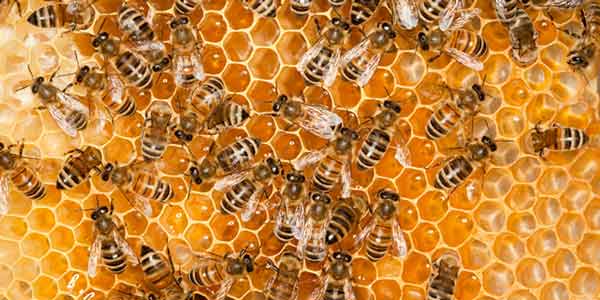Types of Honey Bees: Everything You Need to Know About Them
All living things are distinct from one another when it comes to traits such as productivity, disease resistance, color, temperament, and so forth.
Similar to any other beings, honey bees commonly differ among themselves in many forms and attributes.
Not only genetic differences of a colony can influence the characteristics across different breeds, but the surrounding environment plays a significant role in making distinctions in attributes among bee communities.
For instance, the different varieties of plants available to different communities of bees result in variations in the honey they produce.
For many years now beekeepers have managed to effectively domesticate honey bees and keep them in a relatively controlled environment. Over time this has allowed beekeepers to study and master the differences and traits of the bee communities and to anticipate distinctive characteristics based on their genetic stock.
And thus, they can now utilize a variety of strains to match with their specific purpose, from honey crop to pollination to bee production or resiliency.
It’s important to understand the general attributes and differences between various types of honey bees to ensure you get the right bees for the right purpose.
What Is a Bee Stock?
According to David Tarpy of North Carolina State University, the term “Bee Stock” means an unconstrained combination of characters that depict a specific bunch of bees.
And such breeds can be categorized by race, species, population, region, or breeding streak in a profitable operation.
Most of the present “stocks of bee” in the U.S. can be clustered at more of such points. Hence, the term “stocks” can be considered interchangeably, based on the certain group of honey bees in question.
The simplest way to comprehend Bee strains is to liken it to the method we have used to track and trace full-blood racing horses through the years. Repeatedly, there are ranks of inheritance that directly go back to year after years in class stock.
It is vital to realize that most of the bees available for purchase originate from so-called royal races of bees, which make us understand that the quality queen mating and the excellence of the bee reproduction. However, the “cleanliness” of the bee stock is not at all times easy to regulate.
Wide variation does exist within bee stocks along with among them. So, any simplifications about a specific stock ought to be considered with caution as there is always room for exceptions.
Even so, the vast and extended experience of the beekeepers allows them to assume some oversimplifications with the aim of better understanding the various types of honey bees available.
The statement of Dr. Al Dietz (1992) appeared in the “Honey bees of the world. The Hive and the Honey Bee” helps us greatly to comprehend that even if these genetic strains are deep-rooted in the history, they are nothing more than a way to aid us classifying the basic differences. That means, his statement is also not out of flaws and controversy.
The table below will portray a brief synopsis of a few of the common and commercial bee stocks available in the American territory for the purpose of honey production.
Comparison of Common and Commercial Honey Bees and the Characters
German | Italian | Buckfast | Carniolan | Russian | Caucasian | |
|---|---|---|---|---|---|---|
Color | Dark | Light | Medium | Black | Gray | Dark |
Tracheal | - | - | + | - | + | 0 |
Varroa | - | - | - | - | + | - |
EFB* | 0 | 0 | 0 | 0 | 0 | 0 |
AFB** | - | 0 | 0 | + | 0 | 0 |
Other | 0 | 0 | + | + | 0 | - |
Spring buildup | Low | Good | Low | Very good | OK | Very low |
Gentleness | Low | Moderate | Low-Mod | High | Low-Mod | High |
Ability to adjust with winter season | Very Good | Good | Good | Good | Very Good | OK |
Honey crop production | OK | Very Good | Good | Good | OK | Low |
Excess swarming | OK | OK | Low | High | OK | Low |
Propolis | OK | Low | Low | Low | OK | High |
Other Traits | Short tongue and nice white cappings | Heavy robbing | Supersedure queens harvest defensive colonies | Good comb builders and Low robbing record from neighbors | Queen cells are always present in the colony and brood rearing is affected by flow | Long tongue |
* EFB = European foulbrood
** AFB = American foulbrood
If you want to know: Manuka Honey vs. Raw Honey: Which is Good and Why? click here
What to Consider When Choosing a Bee Stock

The American Bee Journal documented that one should consider 5 key points when he or she is looking for and selecting a bee stock. These factors are mentioned below:
- 1Production
- 2Temperament
- 3Location
- 4Quality of products and
- 5Disease resistance
There are other types of selection criteria which you might want to look into whether you are an experienced beekeeper, fresh beekeeper or would-be beekeeper. These factors include but are not limited to:
- 1Reproduction Rates
- 2Age of line
- 3Swarming Rates
- 4Environmental Resilience
- 5Noted Range and
- 6Much more
There are other criteria that could be considered for different types of farmers and different styles. But those are actually more connected to your goals of keeping bees and why you choose to be a beekeeper.
The Main Types of Honey Bees (Scientific Name: Apis Mellifera)
Bees can be classified by their race, region, population, breeding line or species. Following that suit, there are different types of honey bees available in the world. However, this article is dedicated to the most common and commercially available honey bees in the United States. Without further ado, let’s jump into it.
The German Bee (Scientific Name: Apis Mellifera Mellifera)
The German Bee is also known as Black Bee. Probably, this honey bee was imported to the United States for the first time. They were brought from Northern Eurasia at the time of the colonial era. As the name suggests, they are very dark or black in color.
The Positive Sides:
The goodness with Black bees may be the following:
The Negative Sides:
The most common disadvantages of these bees are the following:
The Italian Honey Bee (Scientific Name: Apis Mellifera Ligustica)
The Italian honey bee is a sub-species belonging to Apis Mellifera Ligustica and originates from Italy. They were brought to America in the period of 1859. Within a short time, they became one of the favorite stocks for beekeepers and have remained the same in popularity to date.
The Italian honey bee is known for extended brood rearing periods. In general, they create colony populations during the season of spring and maintain so till the end of summer.
The Positive Sides:
The key benefits of having an Italian bee are:
The Negative Sides:
Despite the mass popularity of Italian bee among beekeepers, they are not out of some disadvantages, including:
The Buckfast Bee
The Buckfast Bees are named after a place called Buckfast Abbey in Devon in the UK from where they have hybridized and originated.
During the time of the 1920s, bee populations in the British Islands were being thinned by tracheal lice or the acarine disease. Brother Adam who was a priest at the Buckfast Abbey, was given a challenge to create a stock that is capable of fighting off the fatal disease.
He then visited all over the world to talk to beekeepers and study different races of bees. Following that research, he instigated to cross the sturdiest colonies who had endured in the region of Buckfast with Italian race, which was able to survive in the harsh conditions and cold of the British Islands.
Moreover, the new stock was also able to yield a good honey crop and able to follow good housekeeping habits in order to prevent the transmission of diseases. Because of the moderately defensive nature, the Buckfast stock was able to become a favorite stock among farmers.
The Positive Sides:
The benefits of having this stock bee are:
The Negative Sides:
While these bees are only moderately defensive and are popular among beekeepers, they do have some negative sides as well, which are:
The Caucasian Bee (Scientific Name: Apis Mellifera Caucasica)
The Caucasian bee is of the subspecies Apis Mellifera Caucasica. These honey bees are native to the hills of the Ural Mountains adjacent to the Caspian Sea in eastern Europe. It is a race that used to popular in the United States.
Nevertheless, because of a couple of negative features, the farmers progressively lost their favor for it over the preceding few decades.
The Positive Sides:
Most mentionable advantages of the Caucasian bee include:
The Negative Sides:
The drawbacks of this stock include:
The Russian Bee
The Russian Bee is among the newest bee races in the United States. It was brought in by the Genetics, the US Department of Agriculture’s (USDA) Honey Bee Breeding, and a Physiology Laboratory located in Baton Rouge, Louisiana from the far-eastern parts of Russia.
The researchers documented that these bees are from the Primorski region found on the Sea of Japan, and they have existed there for the last 150 years with the disturbing ectoparasite Varroa destructor (a louse that was responsible for unadorned bee colony losses throughout the world).
So, they have assumed that these Russian stocks might flourish in the United States as well.
The USDA scientifically tested whether the Russian Bee had evolved intransigence against the famous Varroa ectoparasites and witnessed that it indeed had.
Many other studies, on the other hand, have shown that these bees have less than half the number of lice, which are found in any standard commercial stocks. In the year 2000, the quarantine stage of this project was completed and the strain became commercially available.
The Positive Sides:
The benefits of rearing this stock would be:
The Negative Sides:
The negative sides of having Russian Bee are:
The Carniolan Bee (Scientific Name: Apis Mellifera Carnica)
The Carniolan Bee is of the subspecies Apis Mellifera Carnica and is imported from Europe. It is also considered a most favorite stock for beekeepers in the US for various reasons.
The Positive Sides:
What makes this bee to one of the top 2 most coveted bees are given below:
The Negative Sides:
The drawbacks related with rearing this stock would include:
They have proven to be a popular stock for Slovenian beekeepers due to their adaptability as they can live with a modest food supply and a colder temperature during winters.
Bonus:
The Africanized Bee
The Africanized bee is well known as a Killer Bee and it does not even originate from Africa but came from Brazil. This bee strain is a hybrid type developed in a laboratory with the aim of increasing parasite and pest resistance while having an increased production of the honey crop.
This honey bee showed to have a great potential until 26 trial swarms escaped from quarantine and settled in South America.
Many beekeepers are frightened with this type of stock by hearing their name, “Killer Bee” and considering them as a threat of being stung to death. In reality, they are actually misunderstood by many when it comes to their traits.
The Positive Sides:
These are the highly aggressive stock of honey bees, which have some benefits if one can learn to deal with them effectively.
The Negative Sides:
The disadvantages linked with breeding and rearing Africanized bee are given below:
The Bottom Line
Even though one could find a huge variation among and within different types of stocks. Still, there are some generalities that exist. You can take advantage of these generalities and variations, based on the attributes or features that interest you the most.
The truth is, there is nothing you will find as the absolute “best” in the globe! So, the same goes for bee strain! The attributes preferred by one farmer may differ greatly from another’s preference.
You may then ask me, what would you do in choosing the right type of stock for you as it seems to be a daunting task to pick the “best” one?
If I were you, then I would try out as many races of bees as possible and choose the bee strains that best suits my situation and the surrounding environment.







